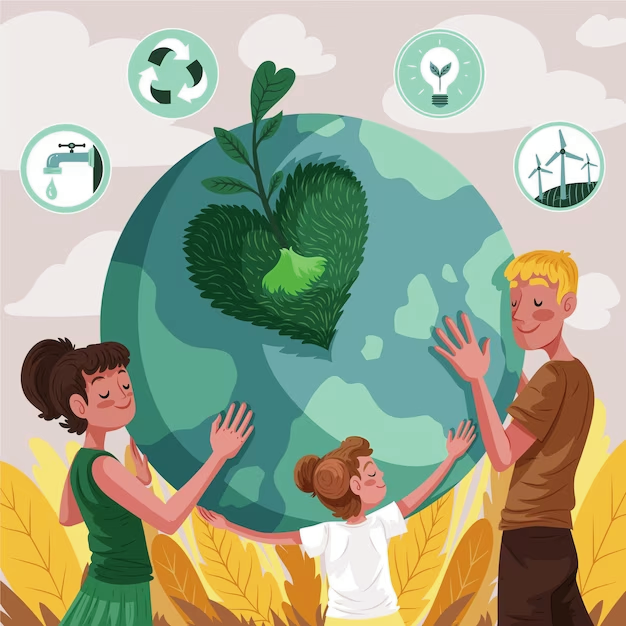Sustainability and Efficiency: Green Practices in Warehouse Control
Arrived EZ2024-01-29T20:02:08+00:00In today’s fast-paced, consumption-driven world, sustainability is more than a buzzword; it’s a crucial guiding principle. Particularly in warehouse control, where the crux of the operation lies in the storage, management, and distribution of goods, the integration of green practices isn’t just a nod to environmentalism—it’s an intelligent business strategy. So, let’s dive deep into warehouse operations and see how sustainability and efficiency aren’t just good pals but essential partners in modern commerce.

The Heart of the Matter: Why Sustainability?
First, why bother? Beyond the obvious moral imperative to care for our planet, sustainable practices in warehouses can lead to a significant reduction in operational costs. We’re talking energy savings, waste reduction, and improved supply chain efficiency. It’s a win-win situation: do good for the Earth and your wallet!
Let’s dive right in, shall we?
First, sustainability isn’t just a buzzword that makes people sound thoughtful at dinner parties. Nope, it’s way more than that. It’s about how we can keep this planet spinning nicely without making a mess of it for future generations. We’ve been taking a lot from Mother Earth—resources, animals, you name it—and we haven’t been the best at giving back. It’s like eating all the cookies from the cookie jar and not leaving any for your little brother. Not cool, right?
Now, let’s talk about why this matters. Imagine your favorite place in the world. Have you got it? Good. Now, picture it in 50 years. It could be more pretty if we keep going the way we are, huh? That’s where sustainability comes in. It’s all about balance. It’s like walking a tightrope, but instead of falling off, we’re trying not to let the planet fall apart.
So, why is it at the heart of the matter?
Well, without a healthy planet, what do we have? A whole lot of nothing, that’s what. It’s like trying to drive a car without gas. Or, better yet, like trying to bake a cake without flour. You get the picture.
It’s not all doom and gloom. There’s some good news, too. More and more people are waking up to the fact that we need to change our ways. From big companies to little kids, the word is spreading. People are recycling more, driving less, and eating less meat. It’s a start, and every little bit helps.
Now, you might be thinking, “What can I do?
I’m just one person.” But here’s the thing – every single person counts. It’s like a puzzle; you need every piece to complete the picture. So, start small. Turn off the lights when you leave a room, use a reusable water bottle, or walk instead of driving when you can. It might not seem like much, but it adds up.
Let’s shift gears a bit. Let’s talk about the big players in sustainability. I’m talking about governments and corporations. They’ve got a massive role to play. We’re seeing more laws and regulations aimed at protecting the environment. And companies? They’re getting in on the action, too. They’re making better products for the planet and telling everyone about them. It’s a win-win. They look good, and the Earth gets a break.
But wait, there’s more. Sustainability isn’t just about the environment. It’s also about people- ensuring everyone has a fair shake at a good life. It’s no good if we save the planet but leave people behind. So, when we talk about sustainability, we also talk about stuff like fair pay, safe workplaces, and the chance to learn.It’s a big old package deal.
So, where does this leave us?
Well, with a bit of hope, that’s where. Sure, there’s a lot to do, which can seem overwhelming. But remember, it’s like eating an elephant—you do it one bite at a time. Every little thing we do to help counts.
Ultimately, sustainability is at the heart of the matter because it’s about keeping our home—this beautiful, crazy, wonderful planet—in tip-top shape. It’s about ensuring there’s enough to go around, not just today but for all the tomorrows to come. It’s about doing our part to leave things a little better than when we found them.
Lighting the Way: Energy Efficiency
One of the most accessible places to start is with lighting. Imagine a sprawling warehouse, vast and filled with aisles of products. Now, picture it lit by energy-guzzling, traditional light bulbs. Not the brightest idea, right? Switching to LED lighting, which consumes a fraction of the energy and lasts way longer, is a no-brainer. Incorporating natural light through skylights or strategically placed windows can reduce reliance on artificial lighting. It’s like letting the sunshine in—literally and figuratively.
Picture this:
Imagine a world where the lights are always on, but the energy bill is way down. Sounds like a dream, right? But hey, this isn’t just pie-in-the-sky thinking; it’s all about energy efficiency. Let’s shed some light on this topic, shall we?
First off, let’s talk about what energy efficiency means. It’s not about sitting in the dark or turning off your AC in the middle of a scorching summer. No siree! It’s about using less energy to do the same job. It’s like being wise with your resources, like using every part of an apple, including the peel, for your recipes.
Now, why is this a big deal? Well, for starters, we use a ton of energy daily. Power plants are chugging along, burning fossil fuels, and that’s causing all sorts of problems. Think about climate change, air pollution, and your monthly utility bills. It’s like we’re running a race with weights tied to our ankles.

But here’s the kicker:
To put it bluntly, a lot of this energy use is wasteful. It’s like leaving the water running while you brush your teeth. So, if we can figure out how to use energy more efficiently, we’re onto something good.
Let’s dive into the how. Energy-efficient technologies are a big part of the puzzle. LED light bulbs, for instance, are like the superheroes of lighting. They use way less energy and last longer than those old-school bulbs. Then, there are energy-efficient appliances, smart thermostats, and even buildings designed to use less energy. It’s like upgrading your old flip phone to the latest smartphone.
But wait, there’s a cherry on top. Energy efficiency saves money. When you use less energy, your utility bills go down. It’s like getting a monthly discount for being innovative with energy use. Businesses love this, too. Lower energy costs mean more money for other things, like giving their employees a well-deserved bonus.
Now, let’s look at the big picture. Energy efficiency is great for the planet. Using less energy is like making power plants use less fossil fuels. This helps reduce bad stuff that goes into the air, like the gases that warm the Earth. It’s like giving Mother Nature a break.
And here’s something cool:
Energy efficiency can create jobs. Yep, you heard that right. Installing solar panels, upgrading buildings, and manufacturing energy-efficient products are jobs that can’t be outsourced. It’s like giving the economy a good, healthy shake.
But, as with anything worth doing, there are challenges. Upfront costs can be a hurdle. Only some people can immediately shell out the cash for a new, energy-efficient fridge or solar panels. And let’s remember old habits. Change can be challenging. It’s like convincing your grandpa to switch from his ancient TV to a flat-screen.
A Breath of Fresh Air: Eco-friendly Building Materials
The materials used in warehouse construction matter, too.Materials that are good for the environment not only help the Earth but can also make the people working with them healthier and safer. We’re talking low-VOC (volatile organic compounds) paints, energy-efficient insulation, and even green roofing systems. It’s about building not just for today but for tomorrow.
Have you ever thought about what goes into building the spaces we live, work, and play in? Hold onto your hats because we’re about to dive deep into a world where buildings aren’t just structures – they’re a breath of fresh air. Welcome to the realm of eco-friendly building materials!
So, what’s the big deal with eco-friendly building materials?
It’s simple yet profound. Traditional building materials often have a hefty environmental price tag – emissions, waste, and energy use. It’s like cooking but leaving many dirty dishes and a smoky kitchen. On the other hand, eco-friendly materials are like a chef who cleans up as they go and uses every bit of ingredient wisely.
First, let’s discuss why this matters. Our planet, lovely as it is, is facing some severe challenges. Climate change is no joke; our building practices play a significant role. Did you know the construction industry is a major contributor to carbon emissions? It’s like a car that’s always running but going nowhere. By switching to eco-friendly materials, we’re turning off the engine and giving the Earth a much-needed break.
Now, onto the stars of the show: the materials themselves. There’s a whole world of eco-friendly building options, each with its own superpowers. Let’s start with bamboo. This stuff is fantastic! It grows like a weed but is as strong as some types of steel. Using bamboo is like hitting two birds with one stone – you get a sturdy building material that’s also kind to the planet.
Then there’s recycled steel. Do you know all those old cars and appliances? Instead of letting them rust away, we can give them a new lease on life in buildings. It’s like recycling but on a superhero level.
But wait, there’s more! Let’s talk about insulation. Traditional insulation can be pretty nasty, but eco-friendly options like sheep’s wool and recycled denim are available. You heard that right – your old jeans can keep the house warm! It’s like giving your clothes a second career.
And let’s remember the humble yet mighty straw bale. Straw, a by-product of grain production, can build super-insulated, cozy homes. It’s like turning waste into treasure.

Now, here’s the kicker:
Eco-friendly building materials aren’t just good for the planet; they’re often better for our health. They usually don’t have as many bad chemicals, so the air inside buildings is cleaner and healthier.It’s like choosing a salad over fast food for your lunch.
But as with anything worth doing, there are challenges. Eco-friendly materials can be more expensive upfront- it’s like paying a bit more for organic food. Depending on your location, finding these materials can be a treasure hunt.
Waste Not, Want Not: Recycling and Upcycling
Waste management is another critical area. By doing really good recycling programs, big storage places can make a lot less garbage that goes into big holes in the ground. But why stop there? Upcycling, transforming by-products or waste materials into new materials or products, takes it a step further. Imagine turning packaging waste into new packaging materials. It’s like the circle of life but for cardboard and plastic.
First things first, let’s get our terms straight. Recycling is like giving materials a second chance at life. Think of it as a phoenix rising from the ashes. You take something old, break it down, and transform it into something new. On the flip side, upcycling is the cool cousin of recycling. It’s all about taking something that’s seen better days and giving it a creative makeover, turning it into something better without breaking it down.
Why is this so important, you ask? Our planet is like a big house, and we’ve been making a mess in it for quite some time. Landfills are overflowing, resources are dwindling, and we realize that this can’t continue forever. It’s like reaching the last cookie in the jar and knowing it’s time to bake some more but in an eco-friendly way.
Recycling is a powerhouse in the fight against waste. When we recycle, we reduce the need to extract new raw materials. This means fewer trees chopped down, less mining, and less energy used. It’s a win-win. Plus, recycling helps tackle that pesky problem of landfill waste. Less trash piling up means a happier, healthier planet.
But here’s the thing: recycling isn’t just a drop in the ocean. When done right, it can have a massive impact. For instance, recycling aluminum cans saves about 95% of the energy required to make new ones from raw materials. It’s like cooking a meal with leftovers and having it taste just as good – if not better – than the original dish.
Now, let’s shine a light on upcycling. This is where creativity meets sustainability. Upcycling is about taking something no longer in use and giving it a new purpose. It’s about looking at an old, worn-out tire and seeing a funky, chic coffee table or taking grandma’s old dress and turning it into a trendy tote bag. It’s sustainable fashion, eco-friendly home decor, and art!
But wait, there’s more. Upcycling has a secret superpower – it’s a mood booster. There’s something deeply satisfying about creating something new with your own hands. It’s like the joy of cooking a meal from scratch but with tools and old stuff.
Of course, it’s not all rainbows and butterflies. Recycling and upcycling face their fair share of challenges. Only some things can be recycled or upcycled; sometimes, the process can be more costly or energy-intensive than producing new items. It’s like trying to bake a cake but realizing only some ingredients suit the recipe.
Lean and Green: Efficient Inventory Management
Now, let’s talk inventory management. A lean inventory managed through practices like just-in-time inventory (JIT) or efficient consumer response (ECR) reduces waste and energy consumption. It’s about having just enough, just in time—like a perfectly timed dance step in the ballet of logistics.
Moving Forward: Sustainable Transportation
Transportation is a big piece of the puzzle. Utilizing fuel-efficient or electric vehicles for transportation and optimizing delivery routes to reduce mileage and emissions is crucial. It’s like choosing the scenic route, but it’s not just about the view; it’s about reducing that carbon footprint.
The Power of Technology: Automation and AI
Here’s where it gets cool. Automation and artificial intelligence (AI) in warehouses can significantly improve efficiency and sustainability. For example, automated guided vehicles (AGVs) can optimize movement within the warehouse, reducing energy use and increasing efficiency. AI can forecast demand, manage inventory, and control the warehouse environment. It’s like having a
conclusion,
The world of warehouse control is evolving, and it’s clear that sustainability and efficiency are no longer separate concepts but rather intertwined in the fabric of modern business practices. As we’ve explored the various green practices, from optimizing inventory management to eco-friendly building materials and recycling programs, it becomes evident that making responsible choices not only benefits the planet but also the bottom line.
But here’s the twist: Sustainability in warehouse control goes beyond the warehouse itself. It’s about fostering a culture of responsibility and conscious decision-making throughout the entire supply chain. It’s about recognizing that our actions today have far-reaching consequences, and every small step toward sustainability counts.
So, as you navigate the world of warehouse control, consider not just the immediate gains but the long-term impact of your choices. Think about the footprint you leave behind, the legacy you build, and the world you want to pass on to future generations.
In the end, embracing green practices in warehouse control isn’t just about being efficient; it’s about being responsible stewards of our planet. It’s about creating a future where sustainability isn’t an option but a way of life. With each eco-conscious decision we make, we’re not just improving our businesses; we’re making the world a better place, one warehouse at a time.












Leave a Reply